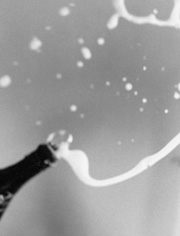Champagne is a wine overburdened with stereotypes. A Chardonnay is just a Chardonnay, but champagne is luxury, privilege, and frivolity. Emma Peel and John Steed drank it constantly—and from the wrong kind of glass, the shallow coupe instead of the correct tulip-shaped one—to make it clear that they didn’t take anything very seriously.
With the idea of champagne so exaggerated, it’s easy to overlook the more crucial question of how it tastes. My earliest experiences with champagne were like bad dates: a sip or two, a silent doubt (“is this what all the fuss is about?”), and then relief when the toasts were done and I could discreetly ditch the glass. Champagne, it seemed, was a ritual necessary for weddings and New Year’s Eve, the alcoholic equivalent of fireworks (especially when Cousin Fred shook the bottle before popping the cork).
One Christmas, I was invited to a party where the host handed me a glass of something absolutely incredible. It sparkled; it glowed. It was as light as air on my tongue, with lingering smooth flavors of fruit and heaven. It cost at least half my monthly rent, but I was hooked.
Strictly speaking, “Champagne” is a particular kind of sparkling wine from a cool coastal region in northern France. (California “champagnes” are, technically, sparkling wines made in the style of Champagne.) The bubbles in “bubbly” come from carbon dioxide, created during the fermentation process, and sparkling wines are fermented in heavy reinforced bottles so the fizz stays put. The earliest sparkling wines were probably made by accident, but champagne has been a rigorous study in France since at least the 17th century. Today, it is made as follows: The clear juice from black (Pinot Noir) and white (Chardonnay) grapes is blended, fermented once, bottled, fermented again, and its sediment removed. If the champagne is going to be sweet (Demi-Sec or Doux), sugar is added at this point. Dry, or Brut, champagne is not sweetened.
Since a top-of-the-line French champagne costs $150 or more, I asked Jennifer O’Niel at the Pike & Western Wine Shop (1934 Pike Place Market, 441-1307) for help in choosing some less extravagantly priced sparkling wine for the holidays. One of her recommendations was the special holiday Veuve Cliquot champagne, sold in a box that converts to an ice bucket ($57). (Without the bucket, the same champagne is about $45.) At the inexpensive end, O’Niel recommended Zardetto Spumanti, a dry Italian sparkling wine selling for under $10.
The next step was to zero in on the best sparkling wines in the midrange cost category. I gathered a small focus group, and we sampled some of O’Niel’s recommendations. The favorite, by consensus, was a non-vintage Louis Roederer Brut Premier champagne (about $45). It had a rich, smooth taste with “lots of grape.” We compared it with a champagne-style sparkling wine from Roederer’s Californian enterprise, a Roederer Estate Anderson Valley Brut. This American version of French champagne was less expensive ($20) and very nice to drink—smooth, flavorful—but with less richness and complexity than the Brut Premier.
Next, we compared two sparkling wines made in the Willamette Valley by Argyle: a 1996 vintage Brut ($17) and a 1989 vintage Extended Tirage Brut ($30). The 1996 Brut was made from 80 percent Chardonnay grapes and 20 percent Pinot Noir, and it had a sharp, clear taste, light on the tongue and very dry. Some in the group found it too harsh, but I liked it. The Extended Tirage had a higher percentage of Pinot Noir grapes (60 percent), giving it deeper flavors and a hint of color in the glass. This wine, like the 1996, was very dry as well as delicious.
Finally, we sampled a demi-sec Veuve Cliquot Ponsardin ($24 a half bottle), a sweeter champagne that found resounding support in the focus group: not too sweet, well-rounded, with faint flavors of butter and cocoa.
For gift-giving to couples, half bottles are nice: Not only are they a less expensive way to let people sample high-status sparkling wines, but they’ll save your gift recipients from the sad morning-after ritual of tossing out the leftover champagne—which with any of these smooth, delicious champagnes is surely a crime.
Carol Poole is a freelance writer in Seattle.







